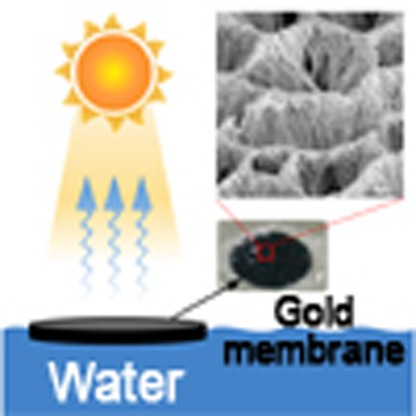- Record: found
- Abstract: found
- Article: found
Flexible thin-film black gold membranes with ultrabroadband plasmonic nanofocusing for efficient solar vapour generation

Read this article at
Abstract
Solar steam generation has been achieved by surface plasmon heating with metallic nanoshells or nanoparticles, which have inherently narrow absorption bandwidth. For efficient light-to-heat conversion from a wider solar spectrum, we employ adiabatic plasmonic nanofocusing to attain both polarization-independent ultrabroadband light absorption and high plasmon dissipation loss. Here we demonstrate large area, flexible thin-film black gold membranes, which have multiscale structures of varying metallic nanoscale gaps (0–200 nm) as well as microscale funnel structures. The adiabatic nanofocusing of self-aggregated metallic nanowire bundle arrays produces average absorption of 91% at 400–2,500 nm and the microscale funnel structures lead to average reflection of 7% at 2.5–17 μm. This membrane allows heat localization within the few micrometre-thick layer and continuous water provision through micropores. We efficiently generate water vapour with solar thermal conversion efficiency up to 57% at 20 kW m −2. This new structure has a variety of applications in solar energy harvesting, thermoplasmonics and related technologies.
Abstract
 Efficient steam generation under solar irradiation is of interest for energy harvesting
applications. Here, Bae
et al. develop a plasmonic nanofocusing film consisting of metal coated alumina nanowires
to efficiently generate solar vapour with an efficiency up to 57% at 20 kWm
−2.
Efficient steam generation under solar irradiation is of interest for energy harvesting
applications. Here, Bae
et al. develop a plasmonic nanofocusing film consisting of metal coated alumina nanowires
to efficiently generate solar vapour with an efficiency up to 57% at 20 kWm
−2.
Related collections
Most cited references21
- Record: found
- Abstract: found
- Article: not found
Taming the blackbody with infrared metamaterials as selective thermal emitters.
- Record: found
- Abstract: found
- Article: not found
Solar vapor generation enabled by nanoparticles.
- Record: found
- Abstract: found
- Article: not found